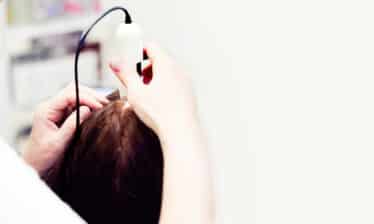Genital itching or irritation can be awkward or embarrassing to discuss and seek help for, especially if you’re a woman. But this condition is a lot more common than you think. Read on to learn everything you need to know about vulvar dermatitis causes, signs and symptoms, therapies, and more.
What is Vulvar Dermatitis?
The internal portion of the female genital area is the vagina. The external part is the vulva. This area includes the vaginal opening, the folds of skin that surround the vagina (labia majora and labia minora), the clitoris (a collection of nerves), and the urethral opening (used for urination).1
Vulvar dermatitis is a skin condition in which the skin of your vulva becomes irritated so you may experience symptoms like dryness and itchiness.2
This condition can occur at any age, but you’re at a higher risk before puberty and after menopause. This is because your estrogen levels are particularly low before you hit puberty and once you experience menopause. Regular periods help to maintain your estrogen levels. Without estrogen, your vulvar skin becomes thin, dry, and prone to irritation or injuries.3
The vulvar skin is usually soft and tender but becomes inflamed in vulvar dermatitis. This condition can be categorized into two main types: atopic dermatitis and contact dermatitis. 4
Vulvar Dermatitis Signs and Symptoms
Here’s a list of the most common vulvar dermatitis signs and symptoms you may experience:5
- Itchiness or irritation
- Redness
- Swelling
- Pain or discomfort
- A burning or raw sensation
- A wet feeling or fluid discharge
- Patchy skin that may be darker or thicker than the surrounding areas
Your symptoms can range from mild to severe. They could even worsen at specific times like at night, on hot or muggy days, when you’re on your period, or when you have sex.6
Vulvar Dermatitis Causes
Vulva dermatitis can occur for many reasons. Contact dermatitis happens when your vulvar area comes into contact with certain irritants or allergens.7
Examples of common irritants include8:
- Soaps with harsh chemicals
- Rough or scented toilet paper
- Laundry products (like detergents and fabric softeners)
- Feminine hygiene products (like tampons or douches)
- Hair removal products (like razors and creams with bleaches)
- Loofahs or washcloths
- Friction caused by tight-fitting clothes
- Washing too much
- Shaving or waxing the vulva
- Rough sex
Examples of popular allergens that could cause vulvar dermatitis include strong perfumes or deodorants, lubricants, spermicides, scented oils or lotions, undergarments with azo dyes in them, and rubber items (like condoms, menstrual cups, and gloves). Allergic reactions can occur suddenly or worsen gradually.9
Atopic dermatitis (or vulvar eczema) is a non-contagious, dry skin condition characterized by itchiness. The term ‘atopic’ indicates a tendency to develop conditions like eczema, hay fever, and asthma. It mainly occurs due to a defective skin barrier as your skin may not produce enough oils, resulting in dryness and irritation.10
Other causes of vulvar dermatitis include:11
- Pubic lice
- Shingles (chicken pox-related viral infection)
- Autoimmune skin conditions like psoriasis
- Infections like yeast and candida
- Lichen planus or lichen sclerosus
- Cancer (rare)
Preventing Vulvar Dermatitis
Here are some small lifestyle changes you can make to minimize your risk of vulvar dermatitis:12
- Opt for loose-fitting and comfortable clothes (especially underwear and pantyhose) made from soft, breathable, and moisture-wicking fabric.
- Don’t wash your genital area too frequently or roughly. Once a day is enough in most cases.
- Avoid using strong soaps or overly hot water for bathing and washing. Gently pat dry the vulva after cleaning it every time.
- Change out of damp or sweaty clothing immediately, especially after strenuous activities like traveling, playing sports, working out, and swimming.
- Don’t use any products with chemicals in them (e.g., scented bathing or feminine hygiene products, harsh laundry detergents, fragranced or flavored lubes, and condoms).
- Practice safe sex to avoid picking up any infections. Avoid rough or frequent sex as excess stimulation to the genital area can cause irritation.
Living With Vulvar Dermatitis
Although vulvar dermatitis is not contagious, it might be a good idea to refrain from sex while you’re dealing with this condition. This is because the bodily fluids produced and skin-to-skin friction that occurs during sex (no matter how gentle) can further irritate your inflamed vulva and worsen your symptoms, delaying your healing time.13
The ideal option is to wait for it to heal completely before engaging in any form of sexual intimacy. If you notice that your symptoms aren’t improving even after several days, consider seeking medical advice. In the meantime, if you have sex, here are some precautions you can take to avoid aggravating your condition:14
- Use natural and non-irritant oils like coconut oil for lubrication instead of a commercial lubricant, which may contain harsh chemicals.
- Use polyurethane condoms, preferably not perfumed or flavored, without spermicides.
- Use non-scented and mild cleaning products for aftercare. Avoid washcloths and douching with too hot water.
Vulvar Dermatitis Treatment Options
If your symptoms aren’t too severe and you’re able to guess the cause, you could try treating your dermatitis at home with over-the-counter medications like anti-itch creams, steroid ointments, and allergy or antihistamine medications.15
Stop using the products that are the most likely culprits for the irritation or allergy. Wash the area with a mild soap or soak in baking soda for a few minutes, pat dry softly, and use a non-scented moisturizer or petroleum jelly. Consider using commercially available powders (but not talcs) to absorb moisture.16
Wear non-irritant clothing (e.g., cotton fabric), and use a cold compress for relief from irritation.17
If your symptoms don’t resolve within a fortnight (15 days) at max, you probably require professional guidance for vulvar dermatitis treatment.18
When to Speak to Your Doctor
Consult your health care provider immediately if you experience any of the following less common (or red alert) symptoms as these could be signs of sexually transmitted, urinary, or systemic (whole-body) infections that require medical attention:19
- Fever with or without chills
- Bad-smelling or unusual-looking vaginal discharge
- Vaginal bleeding
- Burning or pain while peeing
- Worsening symptoms (e.g., increasing pain or swelling that extends to your vaginal area)
- Painful blisters, rashes, lesions, or skin patches with unusual appearance or texture
Vulvar dermatitis can be frustrating to experience. But good hygiene habits and a few lifestyle changes can significantly decrease your chances of getting it. Check out My Skin Treatment today for more valuable information about this and other skin conditions.
SOURCES:
- Cleveland Clinic: “Vulvar Dermatitis.”
- Cleveland Clinic: “Vulvar Dermatitis.”
- Cleveland Clinic: “Vulvar Dermatitis.”
- Obstetrics and Gynecology Clinics of North America: “Atopic and Contact Dermatitis of the Vulva.”
- Iowa State University: “Vulvar Dermatitis.”
- Cleveland Clinic: “Vulvar Dermatitis.”
- American College of Obstetricians and Gynecologists: “Disorders of the Vulva: Common Causes of Vulvar Pain, Burning, and Itching.”
- American College of Obstetricians and Gynecologists: “Disorders of the Vulva: Common Causes of Vulvar Pain, Burning, and Itching.”
- American College of Obstetricians and Gynecologists: “Disorders of the Vulva: Common Causes of Vulvar Pain, Burning, and Itching.”
- National Eczema Society: “Atopic eczema.“
- American College of Obstetricians and Gynecologists: “Disorders of the Vulva: Common Causes of Vulvar Pain, Burning, and Itching.”
- Cleveland Clinic: “Vulvar Dermatitis.”
- Cleveland Clinic: “Vulvar Dermatitis.”
- University of Iowa Hospitals and Clinics: “Vulvar skin care guidelines.”
- University of Iowa Hospitals and Clinics: “Vulvar skin care guidelines.”
- University of Iowa Hospitals and Clinics: “Vulvar skin care guidelines.”
- Iowa State University: “Vulvar Dermatitis.”
- Iowa State University: “Vulvar Dermatitis.”
- Iowa State University: “Vulvar Dermatitis.”






